Why learning how to braise Belgian Endives is so important?
Everyone in Belgium needs to learn how to braise Belgian endives, commonly known as chicons or witlof in Belgium, at some point in their life. It should almost be a requirement for citizenship. Many people are a bit intimidated by Belgian endives because they are easy to overcook or often fall apart while cooking. Yet, braising Belgian endives is actually fairly simple.
How to braise Belgian endives
All it takes to braise Belgian endives is a pan, some olive oil or butter, garlic, a touch of nutmeg, a sprinkle of sugar and a little water. From start to finish it should take about 20 to 30 minutes. Thankfully it’s so easy because braised Belgian endives are often served as a side dish during autumn and winter, accompanying many family dinners.
How to use braised Belgian endives
Braised Belgian endives taste great with roasted lamb, steak or chicken.
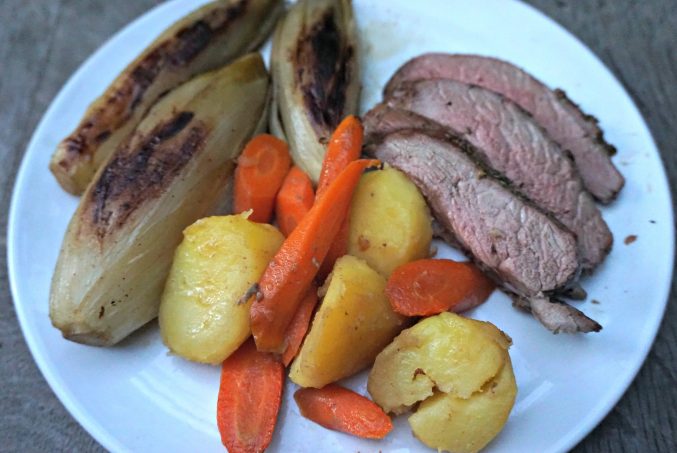
They are also the main ingredient in chicons au gratin, a Belgian national dish, consisting of braised Belgian endives wrapped in slices of baked ham and covered with a white sauce (Béchamel sauce) with some grated cheese.

For a more original idea for using braised Belgian endives see my recipe for Belgian Endive Pie posted last August. This pie requires only one additional step after braising the Belgian endives. Consider accompanying your Belgian Endive Pie with a bowl of soup or a salad.
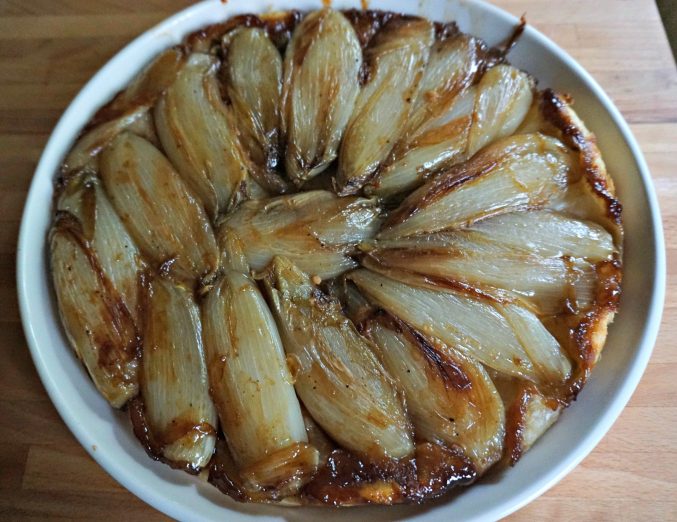
Cultivation of Belgian endives
Belgian endives are traditionally cultivated completely underground or in soil in a dark place, such as people’s basements, to avoid the light causing the leaves to turn green. Nowadays most Belgian endives available in the grocery store are grown through hydro-culture (without any soil). Belgian endives are rich in many vitamins and minerals, including folate and vitamins A and K, as well as being high in fiber. As you can imagine, Belgian endives grown through hydro-culture unfortunately contain fewer vitamins and minerals.
Reducing the bitterness of Belgian endives
Many people find Belgian endives too bitter and need to acquire a taste for them. Belgian endives lose however some of their bitterness when braised, especially with a sprinkle of sugar. Cutting off the bottom of the trunk of the Belgian endives will also reduce their bitterness. Be sure though to cut off this end after braising the Belgian endives. If you cut them off beforehand the leaves of the Belgian endives will fall apart.
Try braising Belgian endives soon to accompany a special meal. Don’t be intimidated by it’s apparent delicate nature. You will be surprised by the ease of this recipe and the result. Please share this recipe with your friends and leave your comments below with your feedback.
Braised Belgian Endives
Ingredients
- 1 kg Belgian endive either whole or cut in half lengthwise
- 2 tbsp olive oil or a little less butter
- 1/4 tsp salt
- black pepper
- 2 cloves garlic
- 1 dash nutmeg
- 1 tbsp brown sugar or white sugar
- 60 ml water (start with a little water and add more if you need it).
Instructions
- Wash the Belgian endives. Remove outer leaves. Cut each Belgian endive in half lengthwise.
- Pour the olive oil or the butter in a pan over a medium heat. Add the Belgian endives, salt and pepper. Saute about 5 minutes turning the Belgian endives over a couple times to get them brown.
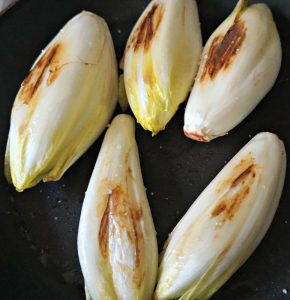
- Add the nutmeg, minced garlic and sugar. Continue to cook for another minute or so, turning them over once.
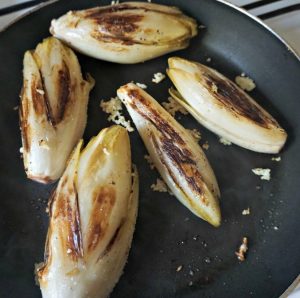
- Add a little water and continue to cook over until the endives become tender (about 10 to 15 minutes more). Turn them over from time to time to get all sides sauteed but be gentle since endives have a tendency to fall apart (like onions) when cooked.
- Adjust the seasoning. Serve them and enjoy!
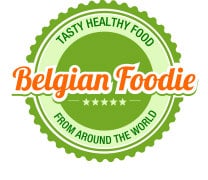
Good post. I never could really cook my chicons the way they should be and how I liked them when reminiscing my grandma’s cooking. I never added brown sugar. Probably the reason why they’re not really tasting the way I’m expecting them to taste. I also like them raw (way easier) with olive oil or with green beans and tomatoes.
Hello Nadine, thanks for your comments. The brown sugar is not absolutely necessary but does help offset some of the bitterness of the Belgian endives (chicons) and helps to caramelize them. Less sugar can also be used. I also love them raw with a little nut oil (walnut, hazelnut, pistachio…) and olive oil. I like them with an apple cut up and added as well or with Roquefort of blue cheese. Oh, so many ways to enjoy them!
HI! I’m from Belgium & raised their during the War. My mother use to cook (Chicon’s) in a Frying Pan with butter & a little water and Shallots. Cut of the stem and place the leaves in the pan and add a lot of salt and pepper to rid of the bitterness. DELICIOUS
It’s so nice to hear how your mother prepared Belgian endives. Thank you, Jacques, for sharing your experience.
HI! Another way my mother served Belgium Endives was to slice them from end to stem with thin sliced Onions, Diced apples and white beans, Olive oil, white vinegar salt & pepper. Delicious
Jacques
Just tried this recipe and have received a big thumbs-up from my Belgian husband!
So happy to read this news, Caroline!
Tried this recipe last night. I have cooked them several times in the past but never with garlic and brown sugar. Outstanding! I omitted the nutmeg but may try it next time. Thanks for this fine Belgian endive recipe.
Thanks, Mark! Much appreciated! Always happy to hear readers enjoying a recipe.
I recently read that the beautiful then Princess Astrid made an endive salad her mother had taught her to cook, for Prince Ludwig. It was their joke that the salad was so good he fell in love with her.
I can’t find the recipe anywhere. Would you possibly have it.